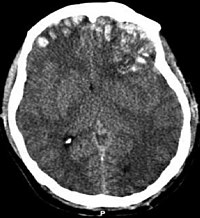
Photo from wikipedia
Abdominal acute pain is a manifestation of heterogeneous medical conditions, with difficult clinical-laboratory assessment. Multi-detector CT (MDCT) is the gold standard imaging technique for evaluating adult patients with acute abdominal… Click to show full abstract
Abdominal acute pain is a manifestation of heterogeneous medical conditions, with difficult clinical-laboratory assessment. Multi-detector CT (MDCT) is the gold standard imaging technique for evaluating adult patients with acute abdominal pain. Due to its fast execution and the high spatial resolution, CT is fundamental in the diagnostic and therapeutic work-up of patients with time-dependent pathology that could require surgical treatment, reducing mortality and morbidity. However, the radiological risk connected to the ionizing radiation use should not be underestimated, especially in young patients. The aim of this study is to identify optimized CT protocols to apply in the management of non-traumatic acute abdomen. In particular, this review is focused on the main emergency settings: acute pancreatitis, small bowel obstruction, acute appendicitis and acute diverticulitis. This survey would not be complete without mentioning Dual-Energy CT (DECT) technique, one of the last frontiers in CT, achieving encouraging results also in acute abdominal conditions.
Journal Title: European review for medical and pharmacological sciences
Year Published: 2022
Link to full text (if available)
Share on Social Media: Sign Up to like & get
recommendations!